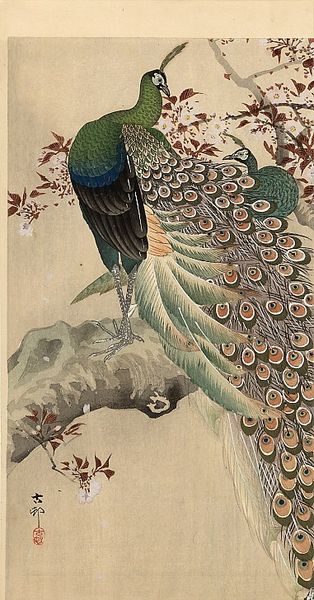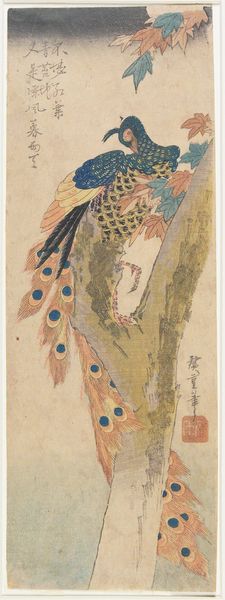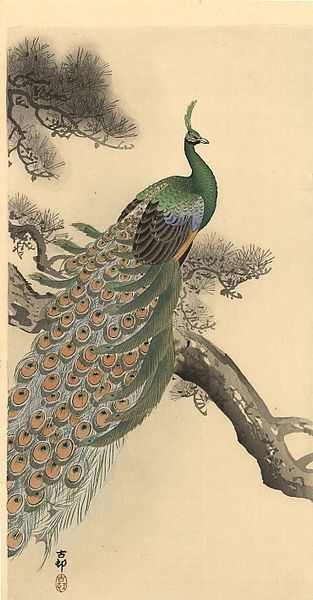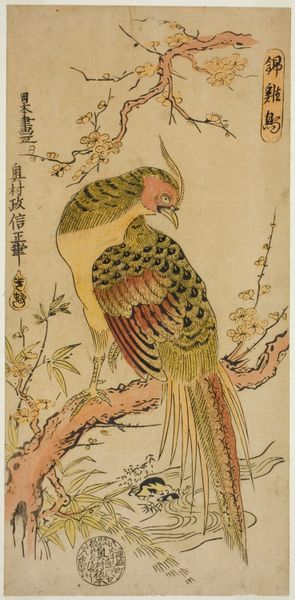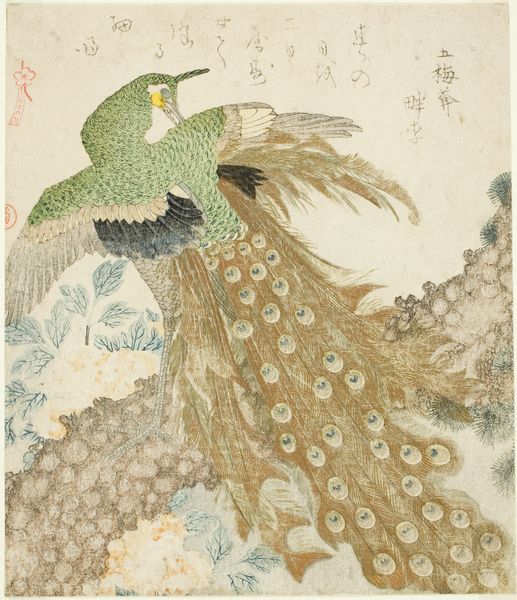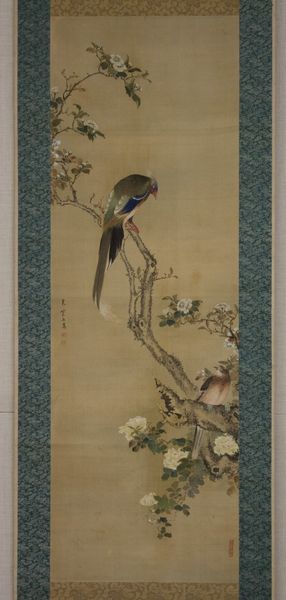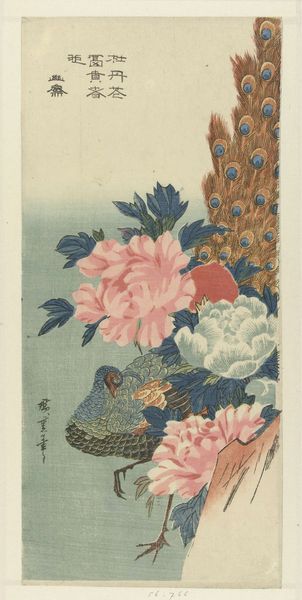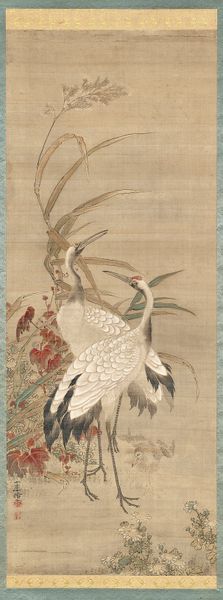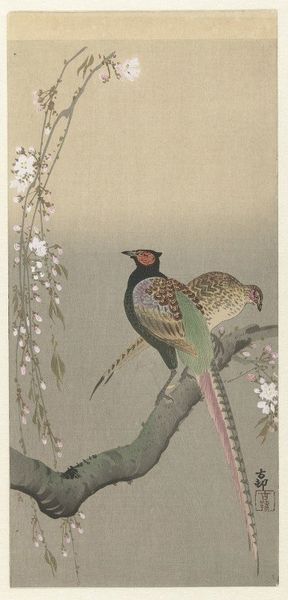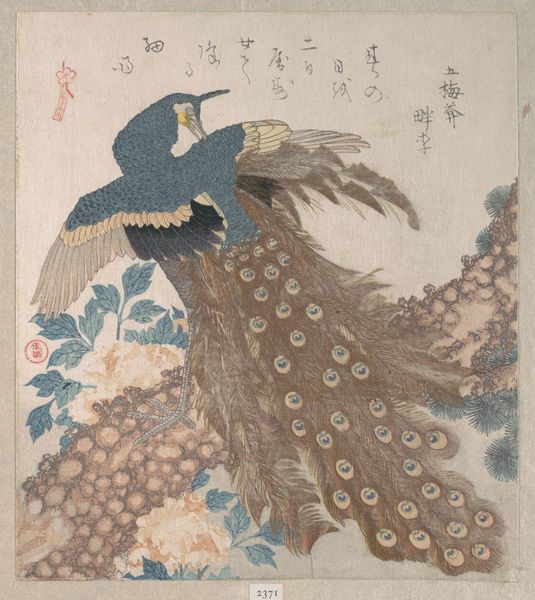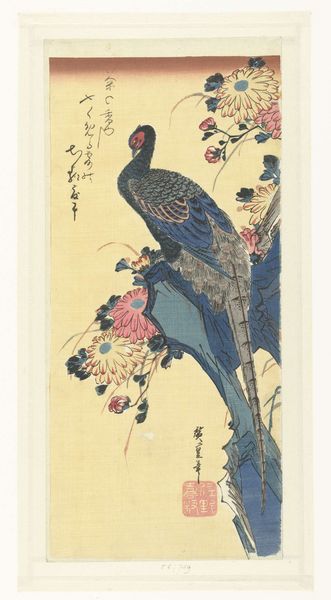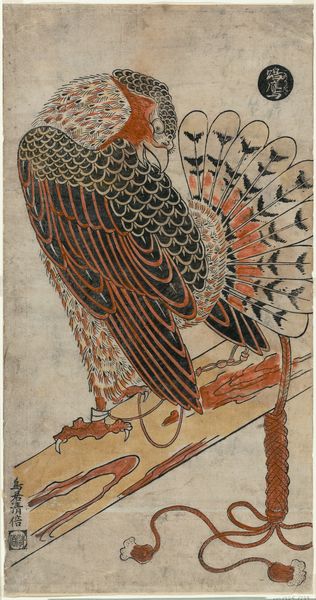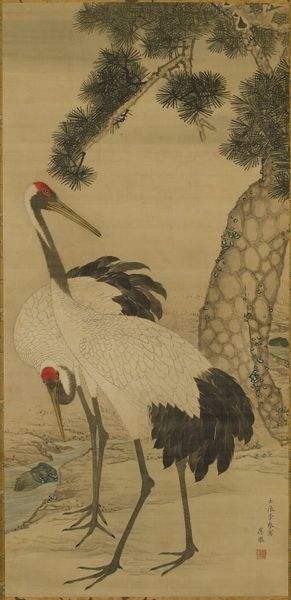![Peacock and flowers [right of a pair of Birds and Flowers] by Nagasawa Roshū](/_next/image?url=https%3A%2F%2Fd2w8kbdekdi1gv.cloudfront.net%2FeyJidWNrZXQiOiAiYXJ0ZXJhLWltYWdlcy1idWNrZXQiLCAia2V5IjogImFydHdvcmtzLzgwZDEwMDdkLWEyYjEtNDBjNC1hMjFjLTZiOTg2ZGU2ODllYS84MGQxMDA3ZC1hMmIxLTQwYzQtYTIxYy02Yjk4NmRlNjg5ZWFfZnVsbC5qcGciLCAiZWRpdHMiOiB7InJlc2l6ZSI6IHsid2lkdGgiOiAxOTIwLCAiaGVpZ2h0IjogMTkyMCwgImZpdCI6ICJpbnNpZGUifX19&w=3840&q=75)
Peacock and flowers [right of a pair of Birds and Flowers] c. 1840
0:00
0:00
hanging-scroll, ink
#
asian-art
#
ukiyo-e
#
figuration
#
hanging-scroll
#
ink
#
naive art
Dimensions: 50 1/2 x 22 1/8 in. (128.27 x 56.2 cm) (image)76 x 27 3/4 in. (193.04 x 70.49 cm)
Copyright: Public Domain
Curator: Ah, look at this remarkable hanging scroll, "Peacock and Flowers," attributed to Nagasawa Rosetsu around 1840. It's one half of a pair of bird-and-flower paintings, done with ink on silk. Editor: My first impression is just pure tranquility. The pastel palette feels so gentle, and that peacock perched amidst the soft pink blossoms looks both regal and utterly peaceful. Curator: Absolutely! It exemplifies Ukiyo-e, that celebrated style of Japanese woodblock prints and paintings focusing on scenes of everyday life and the natural world. Notice the contrast between the intricately detailed peacock plumage and the more subtly rendered blossoms. It's like a poem of textures. Editor: Ukiyo-e also often speaks to notions of a floating world, ephemeral beauty, and maybe even a touch of melancholy knowing things will inevitably fade. Peacocks themselves carry significant symbolism in many cultures – representing beauty, pride, even watchfulness. How do you think that interplay affects our interpretation here? Curator: It adds depth, definitely. Perhaps the peacock is guarding those fragile blooms. Or maybe the artist is meditating on the fleeting nature of beauty itself. To me, there is a subtle element of the artist’s own reflection in this piece; they may also ponder what we see and what may come to be. I also cannot help feeling connected to my ancestral homeland of Japan, which fills me with deep appreciation. Editor: Considering the period it was made, the 1840s, Japan was on the cusp of significant social and political change with the looming end of the Edo period. Do you see echoes of that transition, that potential fragility of a beautiful world on the brink? Curator: It's a potent point. Rosetsu, unfortunately, did not live through the Meiji Restoration. And there's a possibility to see this as a longing for harmony during turbulent times. And given it’s one half of a pair, you have to wonder about the visual conversation between the two, now separated, adding another layer of fragmented meaning. Editor: It's remarkable how such a seemingly simple image can hold so many layers. Curator: Absolutely. It just leaves me with a sense of quiet reflection on life and the gentle strength of the spirit. It just pulls me into the natural world so harmoniously, leaving me inspired to be more mindful of everyday moments.
Comments
minneapolisinstituteofart almost 2 years ago
⋮
Artists of the Maruyama School of painting combined Western realism with the indigenous penchant for decorative design to produce works of great naturalism and pleasing visual effect. Nagasawa Roshū, pupil of the progenitor of the school and adopted son of one of its leading masters, was himself a master of this style. This set of paintings is an impressive example of his work and reveals both Roshū's debt to his teacher, Maruyama Ōkyo (1733–1795), and to his adoptive father, Nagasawa Rosetsu (1754–1799). The refined, precise approach clearly suggests Roshū's fidelity to Ōkyo's fastidious style, while other elements reveal the unorthodox approach of Rosetsu, who was fond of juxtaposing subjects of vastly different scale.
Join the conversation
Join millions of artists and users on Artera today and experience the ultimate creative platform.
